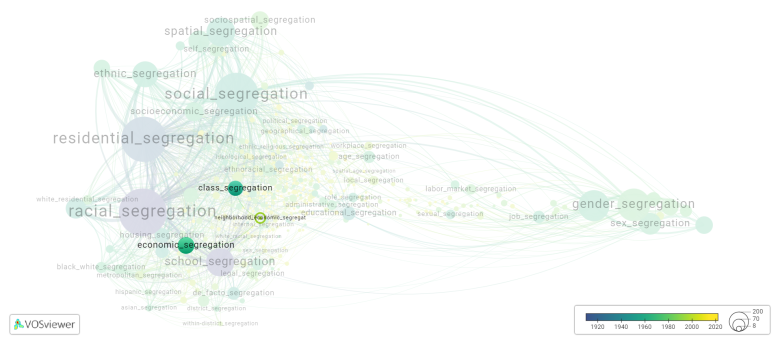Neighborhood economic segregation: Difference between revisions
(Creating page) |
(Creating page) |
||
| Line 22: | Line 22: | ||
income segregation | income segregation | ||
[[neighborhood_economic_segregation.png|780x780px]] | [[File:neighborhood_economic_segregation.png|780x780px]] | ||
For the complete network of associated segregation forms, see: | For the complete network of associated segregation forms, see: | ||
clusters https://tinyurl.com/2d8wg5n3 | clusters https://tinyurl.com/2d8wg5n3 | ||
Revision as of 16:35, 25 September 2024
Date and country of first publication[1]
2004
United States
Definition
Neighborhood economic segregation refers to the division of a community or city into distinct residential areas based on socioeconomic factors, such as income levels, employment opportunities, and access to resources and amenities.
This segregation can occur due to various factors, including historical patterns of discrimination, social and cultural differences, and government policies. It often leads to significant disparities in quality of life, education, health outcomes, and opportunities for upward mobility.
Economic segregation can have negative effects on both individuals and communities. It limits social interaction and the exchange of ideas between people from different economic backgrounds, leading to social isolation and the perpetuation of stereotypes and biases. It can also contribute to the concentration of poverty and the lack of economic diversity within certain neighborhoods, exacerbating inequalities and hindering social mobility.
Various strategies and policies have been proposed and implemented to address economic segregation, such as affordable housing initiatives, mixed-income housing developments, and improved access to quality education and job opportunities. However, reducing economic segregation is a complex challenge that requires a multi-faceted approach involving comprehensive urban planning, equitable distribution of resources, and the promotion of inclusive communities.
Synonyms
The following terms are synonymous with:
neighborhood's economic segregation.
References and literature addressing this segregation form under these synonymous terms can be found below.
See also
Related segregation forms
Neighborhood economic segregation is frequently discussed in the literature with the following segregation forms:
income segregation
 For the complete network of associated segregation forms, see:
clusters https://tinyurl.com/2d8wg5n3
year of publication https://tinyurl.com/2235lkhw
betweenness centrality https://tinyurl.com/223udk5r
disciplines where segregation forms first appeared https://tinyurl.com/244d8unz
For the complete network of associated segregation forms, see:
clusters https://tinyurl.com/2d8wg5n3
year of publication https://tinyurl.com/2235lkhw
betweenness centrality https://tinyurl.com/223udk5r
disciplines where segregation forms first appeared https://tinyurl.com/244d8unz
References
Notes
- ↑ Date and country of first publication as informed by the Scopus database (December 2023).
At its current state, this definition has been generated by a Large Language Model (LLM) so far without review by an independent researcher or a member of the curating team of segregation experts that keep the Segregation Wiki online. While we strive for accuracy, we cannot guarantee its reliability, completeness and timeliness. Please use this content with caution and verify information as needed. Also, feel free to improve on the definition as you see fit, including the use of references and other informational resources. We value your input in enhancing the quality and accuracy of the definitions of segregation forms collectively offered in the Segregation Wiki ©.
Neighborhood economic segregation appears in the following literature
Hardman A., Ioannides Y.M. (2004). Neighbors' income distribution: Economic segregation and mixing in US urban neighborhoods. Journal of Housing Economics, 13(4 SPEC.ISS.), 368-382. Academic Press Inc..https://doi.org/10.1016/j.jhe.2004.09.003
Rothwell J.T., Massey D.S. (201). Density zoning and class segregation in U.S. metropolitan areas. Social Science Quarterly, 91(5), 1123-1143. https://doi.org/10.1111/j.1540-6237.2010.00724.x
Johnson O., Jr. (2014). Still separate, still unequal: The relation of segregation in neighborhoods and schools to education inequality. Journal of Negro Education, 83(3), 199-215. Howard University.https://doi.org/10.7709/jnegroeducation.83.3.0199
